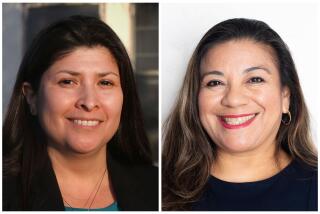Editorial: Traditional L.A. Unified schools and charter schools need to learn to share
- Share via
The tension between charter schools and traditional Los Angeles Unified schools has never been higher. The district is in bad financial straits as a result of lower enrollment, while a new philanthropic group calling itself the Great Public Schools Initiative has plans to fund more charter schools, which attract students from L.A. Unified. That’s just one of many points of friction.
But one problem — the sharing of campuses by both charter schools and traditional schools — has ruffled more feelings than necessary. A proposal that comes before the school board on Tuesday takes a stab at mending fences, but it needs more work.
School districts are required by law to offer unused, surplus space to charters for a fee under a provision of Proposition 39, which was passed in 2000. Though voters may have figured at the time that the proposition referred to schools that would otherwise be closed, in reality, the space is usually at a less-than-full campus.
A few sharing arrangements have worked smoothly, but most have not. You’d be amazed how complicated it can be to define what an empty classroom is. The district might say that a room that seems empty is in fact a computer lab. The charter might respond that there are never any computer classes taking place there.
And how should the space be divided? Should the district school, for instance, have to shorten or change its recess times to make way for the charter students?
L.A. Unified school board member Ref Rodriguez — co-founder of a group of charter schools — proposes to create a task force made up of district and charter leaders, who would work out a more agreeable and transparent system for what is known as “co-location.”
Frankly, it’s hard to imagine the two sides amicably solving this fraught an issue. Charter schools and traditional public schools, which often have very different cultures, are competing for scarce resources. A group of outsiders, acceptable to both sides, might have better luck bridging the gaps.
It’s also important for the school board to set some ground rules from the start. Traditional schools should not be required to give up rooms that are used for classes or running programs, or to switch their recess or gym or cafeteria schedules to suit a charter school. Charter schools, which often have smaller class sizes, shouldn’t be given, say, a classroom for every 15 students if the other school on campus only gets one for every 25 or 30 students. That’s not equity. At the same time, it’s dishonest and unfair for a district school to claim it needs the playing field all day long, or that it must have a particular classroom for science labs even though it has no equipment there and no one is using it.
It might take a third party to arbitrate these disputes, but that would be better than letting usable classroom space go to waste.
Follow the Opinion section on Twitter @latimesopinion or Facebook
More to Read
A cure for the common opinion
Get thought-provoking perspectives with our weekly newsletter.
You may occasionally receive promotional content from the Los Angeles Times.










